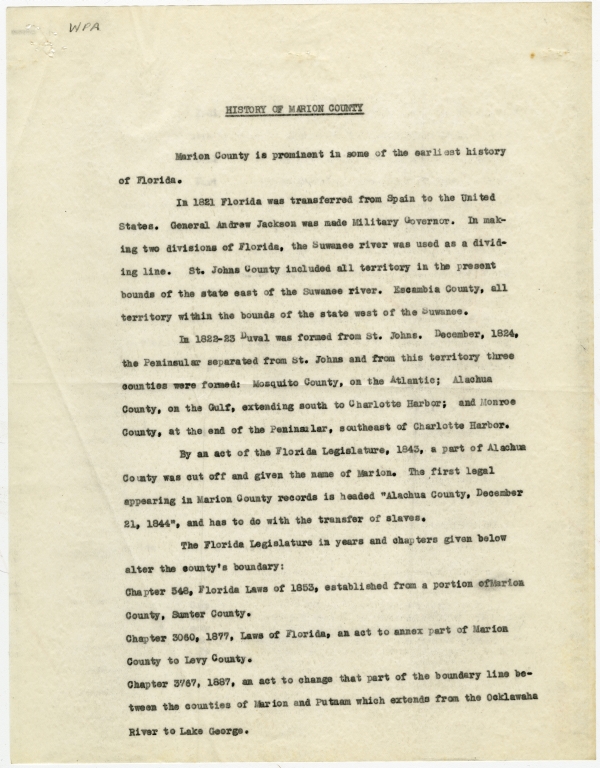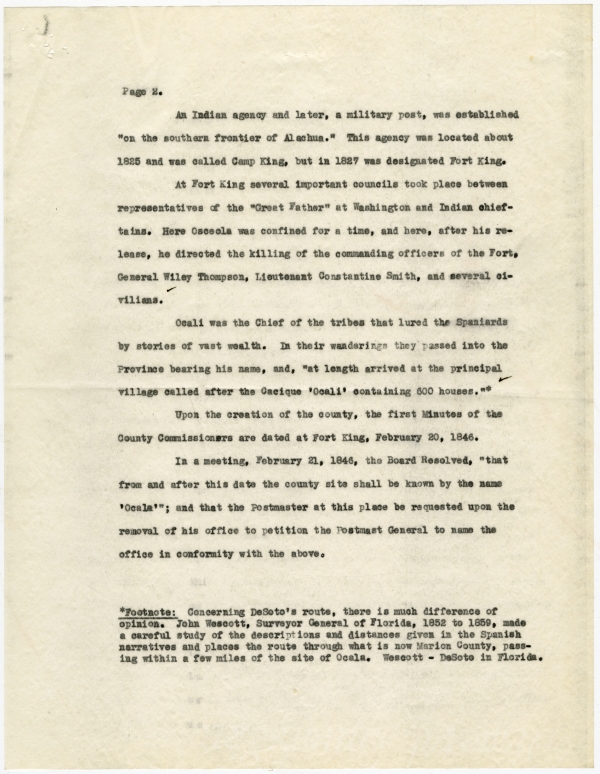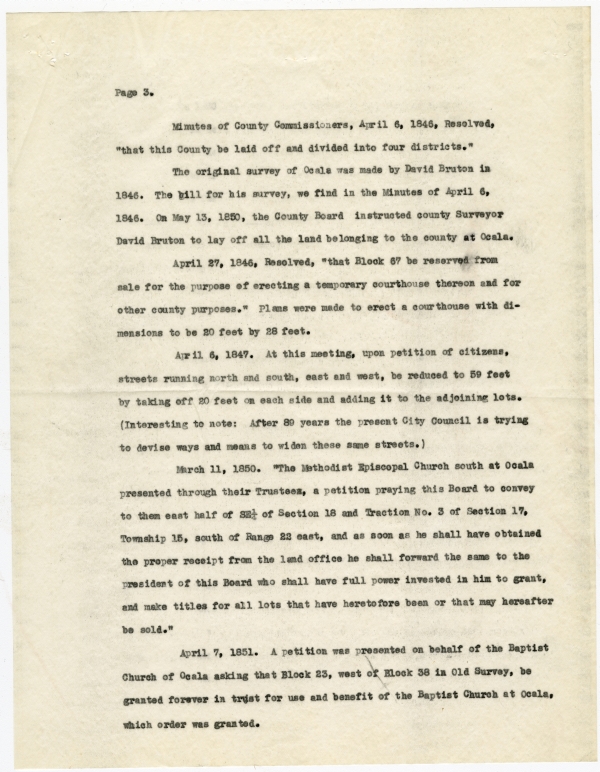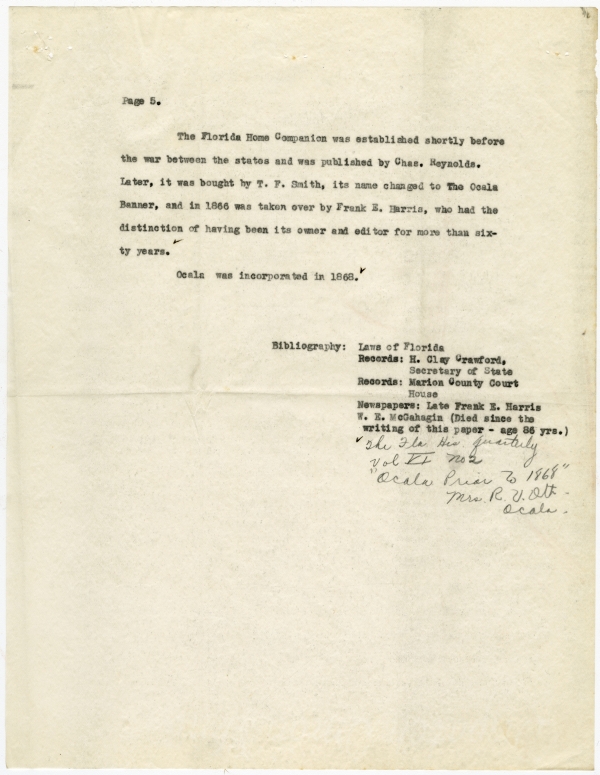Transcript
WPA
HISTORY OF MARION COUNTY
Marion County is prominent in some of the earliest history of Florida.
In 1821 Florida was transferred from Spain to the United States. General Andrew Jackson was made Military Governor. In making two divisions of Florida, the Suwanee river was used as a dividing line. St. Johns County included all territory in the present bounds of the state east of the Suwanee river. Escambia County, all territory within the bounds of the state west of the Suwanee.
In 1822-23 Duval was formed from St. Johns. December, 1824, the Peninsular separated from St. Johns and from this territory three counties were formed: Mosquito County, on the Atlantic; Alachua County, on the Gulf, extending south to Charlotte Harbor; and Monroe County, at the end of the Peninsular, southeast of Charlotte Harbor.
By an act of the Florida Legislature, 1843, a part of Alachua County was cut off and given the name of Marion. The first legal appearing in Marion County records is headed "Alachua County, December 21, 1844", and has to do with the transfer of slaves.
The Florida Legislature in years and chapters given below alter the county's boundary:
Chapter 548, Florida Laws of 1853, established from a portion of Marion County, Sumter County.
Chapter 3060, 1877, Laws of Florida, an act to annex part of Marion County to Levy County.
Chapter 3767, 1887 an act to change that part of the boundary line between the counties of Marion and Putnam which extends from the Ocklawaha River to Lake George.
Page 2.
An Indian agency and later, a military post, was established "on the southern frontier of Alachua." This agency was located about 1825 and was called Camp King, but in 1827 was designated Fort King.
At Fort King several important councils took place between representatives of the "Great Father" at Washington and Indian chieftains. Here Osceola was confined for a time, and here, after his release, he directed the killing of the commanding officers of the Fort, General Wiley Thompson, Lieutenant Constantine Smith, and several civilians.
Ocali was the Chief of the tribes that lured the Spaniards by stories of vast wealth. In their wanderings they passed into the Province bearing his name, and, "at length arrived at the principal village called after the Cacique 'Ocali' containing 600 houses."*
Upon the creation of the county, the first Minutes of the County Commissioners are dated at Fort King, February 20, 1846.
In a meeting, February 21, 1846, the Board Resolved, "that from and after this date the county site shall be known by the name 'Ocala'"; and that the Postmaster at this place be requested upon the removal of his office to petition the Postmast General to name the office in conformity with the above.
*Footnote: Concerning DeSoto's route, there is much difference of opinion. John Wescott, Surveyor General of Florida, 1852 to 1859, made a careful study of the descriptions and distances given in the Spanish narratives and places the route through what is now Marion County, passing within a few miles of the site of Ocala. Wescott - DeSoto in Florda.
Page 3.
Minutes of County Commissioners, April 6, 1846, Resolved, "that this County be laid off and divided into four districts."
The original survey of Ocala was made by David Bruton in 1846. The bill for his survey, we find in the Minutes of April 6, 1846. On May 13, 1850, the County Board instructed county Surveyor David Bruton to lay off all the land belonging to the county at Ocala.
April 27, 1846, Resolved, "that Block 67 be reserved from sale for the purpose of erecting a temporary courthouse thereon and for other county purposes." Plans were made to erect a courthouse with di- mensions to be 20 feet by 28 feet.
April 6, 1847. At this meeting, upon petition of citizens, streets running north and south, east and west, be reduced to 59 feet by taking off 20 feet on each side and adding it to the adjoining lots. (Interesting to note: After 89 years the present City Council is trying to devise ways and means to widen these same streets.)
March 11, 1850. "The Methodist Episcopal Church south at Ocala presented through their Trustees, a petition praying this Board to convey to them east half of SE 1/4 of Section 18 and Traction No. 3 of Section 17, Township 15, south of Range 22 east, and as soon as he shall have obtained the proper receipt from the land office he shall forward the same to the president of this Board who shall have full power invested in him to grant, and make titles for all lots that have heretofore been or that may hereafter be sold."
April 7, 1851. A petition was presented on behalf of the Baptist Church of Ocala asking that Block 23, west of Block 38 in Old Survey, be granted forever in trust for use and benefit of the Baptist Church at Ocala, which order was granted.
Page 4.
In 1850 the first institution of higher learning was established in Ocala by the State (County Commissioners proceedings as to motion) the East Florida Seminary.
February 7, 1853. "The Board of Education for the East Florida State Seminary of Learning, through its Secretary, petitioned the Board of County Commissioners to make a grant of the four acres of land on which the Academy in the town of Ocala now stands." The petition was granted.
Until 1857, when the County Commissioners first made provision to assist in the support, there were few schools and the Seminary was of [inestimable] value to the county.
August 7, 1857. The principal object of this meeting of the Board being the organization of Common Schools in and for County of Marion.
There were several private schools, one of which was the Freestone Springs Academy, a few miles southwest of Ocala, conducted by Chas. H. Bernheim, a Lutheran minister. Private instruction was given at several plantations.
In 1858, H. L. Hart established a six-horse stage coach between Pilatka [Palatka] (early spelling of the town) and Ocala. Later stages were in use between Gainesville, Ocala, Brooksville, and Tampa; these taking the place of riders for mail service.
Marion County's newspaper history dates from 1847, when the "Ocala Argus" was established. The "Marion Star" in 1851, and less than a year "The Conservator", then the following year the "Tropical Farmer", mentioned in the County Commissioners proceedings, 1854, and Cotton States "Florida Home Companion".
See Fla. His. Quarterly Vol 6 #2
Ocala Prior to 1868 by E. R. Ott.
Page 5.
The Florida Home Companion was established shortly before the war between the states and was published by Chas. Reynolds. Later, it was bought by T. F. Smith, its name changed to The Ocala Banner, and in 1866 was taken over by Frank E. Harris, who had the distinction of having been its owner and editor for more than sixty years.
Ocala was incorporated in 1868.
Bibliography: Laws of Florida
Records: H. Clay Crawford,
Secretary of State
Records: Marion County Court
House
Newspapers: Late Frank E. Harris
W. E. McGahagin (Died since the
writing of this paper - age 86 years.)
* The Fla. His. Quarterly
Vol VI No 2
"Ocala Prior to 1868"
Mrs. R. V. Ott.
Ocala.

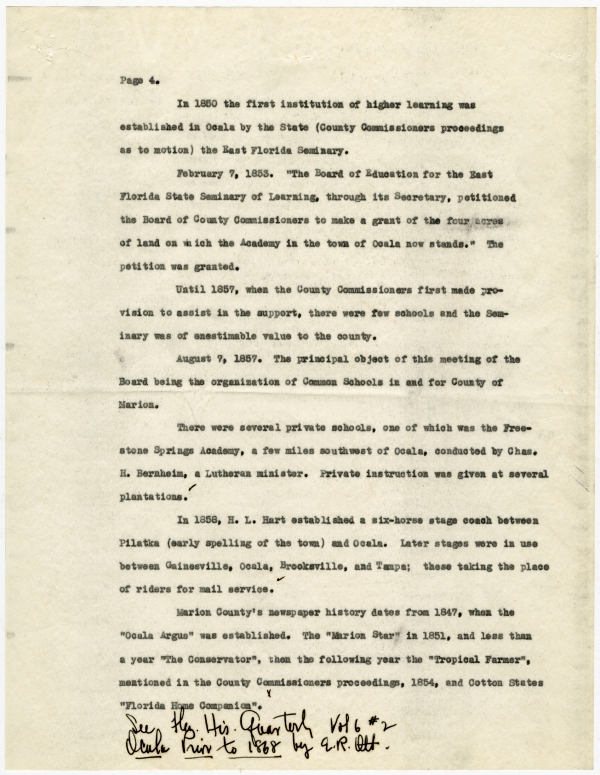


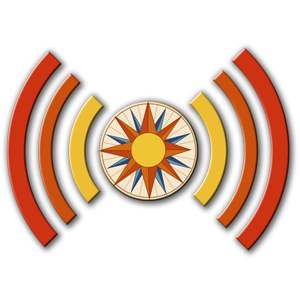 Listen: The Bluegrass & Old-Time Program
Listen: The Bluegrass & Old-Time Program